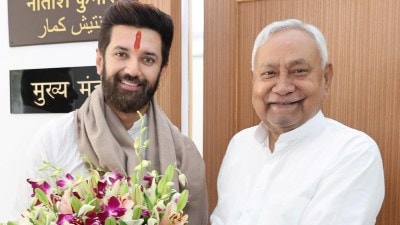Fear of flying
The recent Cabinet decision raising the foreign equity cap for domestic civil aviation from 40 to 49 per cent created some excitement. This ...

The recent Cabinet decision raising the foreign equity cap for domestic civil aviation from 40 to 49 per cent created some excitement. This non-event was perceived to fulfill a Budget promise, suggesting that civil aviation reforms were on track. It also held the prospect of some financial flows. The more meaningful recommendation of permitting equity for foreign airlines was side-stepped. Expectations have also been aroused by Praful Patel’s observations while receiving Part II of the Naresh Chandra Committee Report.
Civil Aviation ministers characteristically have a rather short tenure. While several ministers in the Atal Behari Vajpayee government may have overstayed their welcome, we did see three Civil Aviation ministers. It is ironic that all three were from Bihar, which has the dubious distinction of one of the lowest air penetrations in the country. The present incumbent is in a hurry and not distracted by trappings of petty patronage.
India remains a difficult destination to get in and an equally difficult destination to get out of; low air-linkage density, poor infrastructure and cumbersome procedures add to its woes. Several committees have made worthwhile recommendations, not the least those contained in the Naresh Chandra Committee reports. The ills of civil aviation arise partly from our prevarication. For years, we postponed restructuring of Air-India and Indian Airlines or airport modernisation in the belief that they were being privatised. The civil aviation industry all over the world nosedived in the aftermath of 9/11. When markets were willing, we were undecided, and when we decided, markets had collapsed!
The key areas which need priority attention are:
First, the short run. The benefits of airport privatisation and fleet expansion will at least take two to three years. In the meantime, tourist traffic is rising at 30 per cent and Delhi is the venue of next year’s World Travel & Tourism Council’s Convention. Small investments in optimising the use of the single runway in Delhi; operationalising Mumbai Terminal IA, introducing satellite-based navigation, allocation of optimum flight levels and modernising air traffic management systems will yield quick results. Improving numbers, quality and procedures for immigration management brooks no delay.
Second, to bury the hatchet of privatising Indian Airlines and Air-India, at least in the foreseeable future. They now require fleet augmentation. The leasing by Indian Airlines is primarily for replacing worn-out aircraft and does not substantially augment capacities. It is amazing that proposals made by Indian Airlines three years ago for fleet acquisition first remained pending in the Civil Aviation Ministry for 18 months and thereafter, still await PIB approval. The acquisition programme for Air-India is also proceeding at a tardy pace. Fear of scams makes postponement, instead of decision, a preferred option! It is appalling that proposals for enhancing the equity base of IA recommended by Kelkar years ago to compensate for the grounding of airbuses continue to languish. Given current needs, the equity of both IA and A-I requires substantial enhancement. These can be reflected in the Second Supplementary to be presented to Parliament in the Winter Session.
Civil aviation costs in India, notwithstanding the rate war between operators, are still misaligned with global costs. The single biggest factor is the fuel cost, namely Air Turbine Fuel (ATF). While excise duty has been moderated, the penalty of state sales tax averaging 25 per cent is unacceptable. There will never be consensus among the states, which are cash-strapped, and the remedy lies in notifying ATF as a ‘Declared Goods’, as was done in respect of Turbo Propelled Aircraft. This has been suggested by several committees and reflected in the Tenth Five Year Plan. Further, airline companies should have the flexibility to import ATF in a manner considered most economical. Currently, air travel in the country is cross-subsidised. The burden of servicing uneconomical routes, classified as Category II and III depending on whether they are short or long hauls, is borne by the more paying Category I routes. Route-dispersal strategy should be revisited; the categorisations themselves need a second look. The broader national objective of connecting uneconomical routes should be met either directly by the Budget or through a cess accruing to a non-lapsable fund, with subsidy levels being determined through competitive auctions.
The Open Skies Policy is somewhat of a misnomer. Capacity augmentation has not kept pace with traffic. The policy of bilateral rights is somewhat like ‘‘a dog in the manger policy’’, viz, because we do not have aircrafts to utilise new bilateral rights, we deny these to those who may utilise them! We need to seek new arrangements. The unutilised rights of public carriers should be auctioned to private operators while future rights acquired by the Sovereign should be allocated in the most cost-effective way.
We also need to move with speed in permitting domestic private operators access to West-bound routes, even if the lucrative Middle Eastern routes are reserved for public carriers. The civil aviation industry is rewitnessing a demand upsurge. New orders for aircrafts acquisition or leases have hardened the supply side response. An early decision is necessary to enable private operators to effect most economical contracts.
On airports, luck must favour us. Assuming that the new lease agreements are signed by the middle of next year, visible progress will still be a few years away. The short-term issues deserve priority. Nonetheless, the joint venture process initiated must be brought to an expeditious closure.
Civil aviation improvement is at the centre of tourism, export and investment promotion. Its chequered history of broken promises fills one with weariness, if not despondency. Praful is not used to Flying in the Air; his zest leaves some scope for an optimistic outcome. No one knows better than the Prime Minister and Finance Minister that improved connectivity is cardinal to position India as a new economic power.
write to nksinghexpressindia.com






- 01
- 02
- 03
- 04
- 05

























